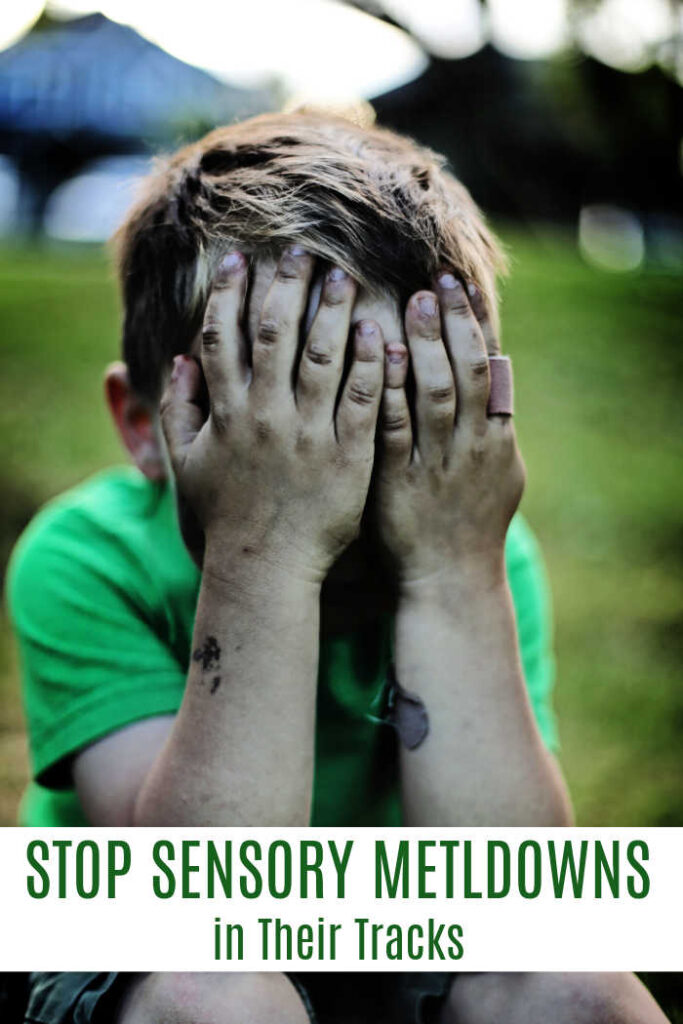Stop Sensory Meltdowns in Their Tracks
My child is one who “goes from calm to overly emotional in less than a split second.”
This was said by a friend of mine when discussing her son’s sensory differences.
While there are reasons specific to her son’s sensory challenges that increase his meltdowns, many parents struggle with the same thing.
If this is something you see in your home (for sensory reasons or not), here are three strategies I have learned to be very effective in decreasing unexpected explosions.
Every child is different, so one strategy may work better than another for you, try them and let me know what you think!
Be sure to check out even more of my helpful parenting tips, too!
This post contains affiliate links.

How to Stop Sensory Meltdowns in Their Tracks
1. Create predictability through routines and transitions
I was researching sensory differences the other day and came across a concept on A Sensory Life.com.
To paraphrase their idea – the world can be a very challenging place (especially for a child with sensory differences) as kids are constantly bombarded with sounds, lights, and environments that can be very overwhelming.
The ONE thing a child can rely on for consistency is the routines integrated into daily activities.
Anyone who is a mom knows that days are anything BUT routine based… nothing goes according to plan.
This isn’t to say every minute of every day needs to follow a strict schedule.
Rather, it is about creating routines for things like; the amount of screen time allowed each day (determine when it will happen and for how long and stick to it), the expectations at dinner (if your child is expected to sit and eat until he is done or maybe not), the things your child needs to do before bedtime stories (brush teeth, put on pajamas) etc.
The more routines a family can create in each day, the more a child knows what to expect and can mentally plan for it, which helps eliminate sensory meltdowns over unmet expectations or unknown expectations.
Transitions are another way to create predictability for kids.
By allowing them a little time in advance to think about what to expect, a child is able to mentally prepare for that activity a little better.
My neighbors (remember how much I ADORE them??) are retired and have two grown children of their own.
They are kind enough to let my kids play at their house every now and then.
One of those times the husband realized it was time for him to be somewhere, stood up, and told the kids it was time to go.
The wife allowed the kids to roughly transition into cleaning up and dealing with it on their own, but gently reminded her husband afterwards that kids need a little more warning before transitioning from one event to another.
Allowing a child a few extra minutes to prepare for a new activity can significantly help decrease meltdowns.
2. Integrate regular play-based sensory activities
A Sensory Life website explains the three power sensations as being proprioceptive, vestibular, and tactile sensory systems.
By integrating activities from any of these three power sensations into daily routines, a child is able to maintain a more stable balance of self-regulation and calmness.
Some examples of power sensation activities are:
- swinging
- jumping
- heavy work (pushing or pulling large objects or carrying heavy objects like a backpack)
- chewing “chewy” food (I recommend things like dried mangos or other things without any added sugar) or chewing chewy objects (ones that don’t present a choking hazard)
- bundling up in a comfortable, soft place
- spinning in an office chair
- inversions such as hand stands, or leaning the head off the couch
All of these, when practiced regularly (long before a meltdown begins..not during) can help promote calmness, and the ability to focus, which in turn decreases meltdowns.
3. Teach kids coping skills
The book, The Explosive Child teaches that often times the reason children explode or have outbursts or meltdowns is due to a lack of coping skills.
Skills like: expressing feelings in a calm manner, thinking of alternate strategies when something doesn’t go as planned, and brainstorming solutions to difficult situations are all very important skills for any adult or child.
Those skills, when taught directly and calmly, can help reduce the need for tantrums and sensory meltdowns as well.
4. Avoid “teaching moments” during sensory meltdowns
All behavior is a form of communication. I was taught that phrase a million times during my undergraduate Child Development degree.
A meltdown is simply a child expressing his/her frustration.
This can come from an inability to deal with the environment or the lack of skills to cope with stress.
The problem is not the meltdown, the meltdown is the result of a problem, one which you can try to figure out after your child has had time to deal with his/her feelings.
When a meltdown has started, emotions are high, the ability to think rationally has come to a screeching halt, which means it isn’t a good time to discuss the problem.
Dr Greene discusses this concept in his book, which for some reason, came as a light illuminating the room for me when I read his book.
I can’t tell you how many times I’ve tried to stop tantrums, attempted to teach my kid a lesson during his fit (verbally of course), or convince him that he needed to calm down so we could talk.
NONE of those work, because emotions are too high.
Dr. Greene, in his wisdom, suggests waiting until after the storm has completely ended and the child is once again calm and rational before even attempting to talk through or teach anything.
As I have taken a step back and re-implemented these simple strategies into my daily routines, I have noticed a difference in the frequency of meltdowns.
I would love to hear your experience with it!
Be sure to hear from other special needs parents, too!
About the Guest Author
This post originally appeared on WendyBertagnole.com and is reprinted with permission.
With an undergraduate degree in child development, and a master’s degree in special education, this foundation was a springboard for Wendy in helping kids and families to see the root of any challenges they face.
